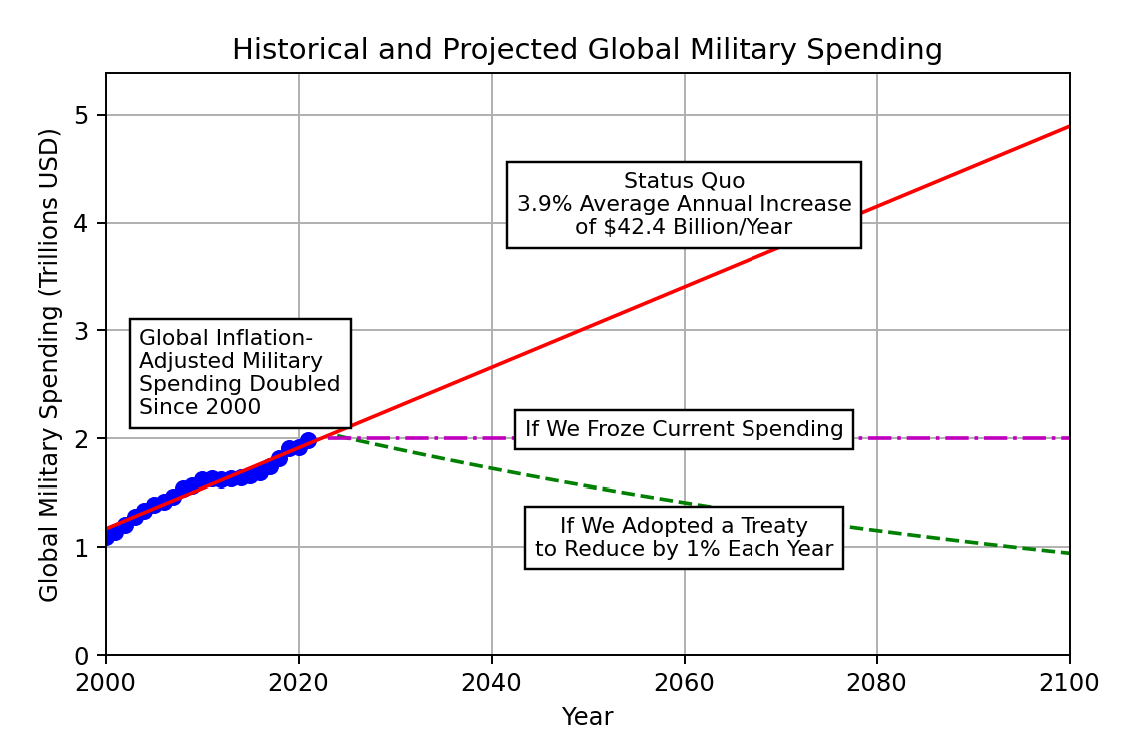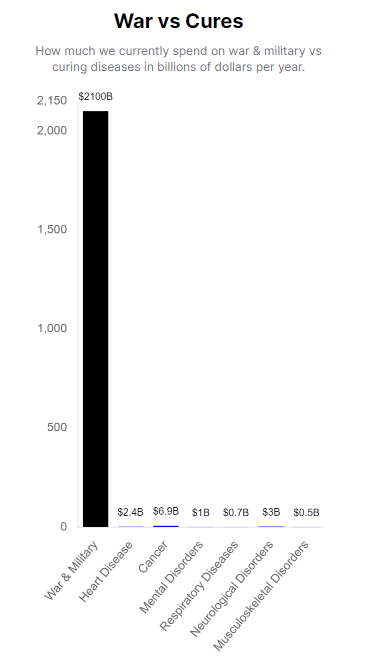¶ Direct Military Spending
Global military spending nearly doubled from $1.1 trillion in 2000 to $1.9 trillion in 2020 (in 2020 inflation-adjusted dollars). This is an average increase of $3.9% or $42 billion a year.

This is 100X more than funding to cure any disease (see cost of disease).

¶ Direct Annual Costs of War:
-
Military Expenditure: $1,981 billion. This reflects the total global spending on armed forces, including salaries, operations, maintenance, and procurement of weapons and equipment.
-
Economic Impact of Conflict: $521 billion. Costs incurred due to the immediate effects of war, such as destruction of property, loss of life, and the displacement of people.
-
Infrastructure Destruction: $1,875 billion. Represents the cost to repair or replace infrastructure damaged or destroyed during conflicts, including roads, bridges, and utilities.
-
Trade and Investment Disruption: $616 billion. Estimated losses from interruptions in trade flows and deterred investments in conflict zones or areas under threat.
¶ Indirect Annual Costs of War:
- Human Costs: $1,000 billion (using statistical value of life). Calculated by applying a monetary value to the loss of life, this figure represents the cost of human casualties of war.
- Opportunity Costs: Lost economic benefits from military spending. Resources spent on military endeavors could have been used for other societal needs, such as education or healthcare.
- Multiplier Effect: Additional economic activity from productive investment. Reflects the lost economic growth that could have been generated if resources were invested in productive sectors rather than military spending.
- Long-term Healthcare for Veterans: $200 billion. Costs associated with providing ongoing medical care, rehabilitation, and support services to veterans injured during military service.
- Psychological Impacts on Populations: $100 billion. Expenses related to treating mental health issues like PTSD, depression, and anxiety stemming from the trauma of war.
- Loss of Human Capital: $300 billion. Economic impact of losing skilled and productive individuals to conflict, affecting the workforce and future earning potentials.
- Environmental Degradation: $100 billion. Costs to address environmental damage caused by warfare, including land degradation, pollution, and loss of biodiversity.
- Refugee Support: $150 billion. Expenses for providing assistance to refugees, including shelter, food, healthcare, and integration services.
¶ Calculations:
- Human Cost of War:
Annual Deaths × Statistical Value of Life - Total Direct Costs:
Military Expenditure + Economic Impact of Conflict + Infrastructure Destruction + Trade and Investment Disruption - Total Indirect Costs:
Human Costs + Long-term Healthcare for Veterans + Psychological Impacts on Populations + Loss of Human Capital + Environmental Degradation + Refugee Support - Updated Total Annual Cost of War:
Total Direct Costs + Total Indirect Costs
¶ Total Annual Cost of War:
- Direct Costs Total: $4,993 billion.
- Indirect Costs Total: $2,245.25 billion.
- Updated Total Annual Cost: $7,238.25 billion.
¶ Total Cost to the Average Person Over Their Lifetime
Assuming a global population of 7.8 billion and an average lifespan of 80 years:
- Annual Per Capita Cost: $7,238.25 billion / 7.8 billion = $928.24
- Lifetime Cost Per Person: $928.24 × 80 years = $74,259.2
The comprehensive annual cost of war, factoring in both direct and indirect costs, is approximately $7,238.25 billion. This equates to $74,259.2 per person over an 80-year lifespan.
¶ References
For the treaty that proposes redirecting a portion of this spending, see the 1% Treaty.